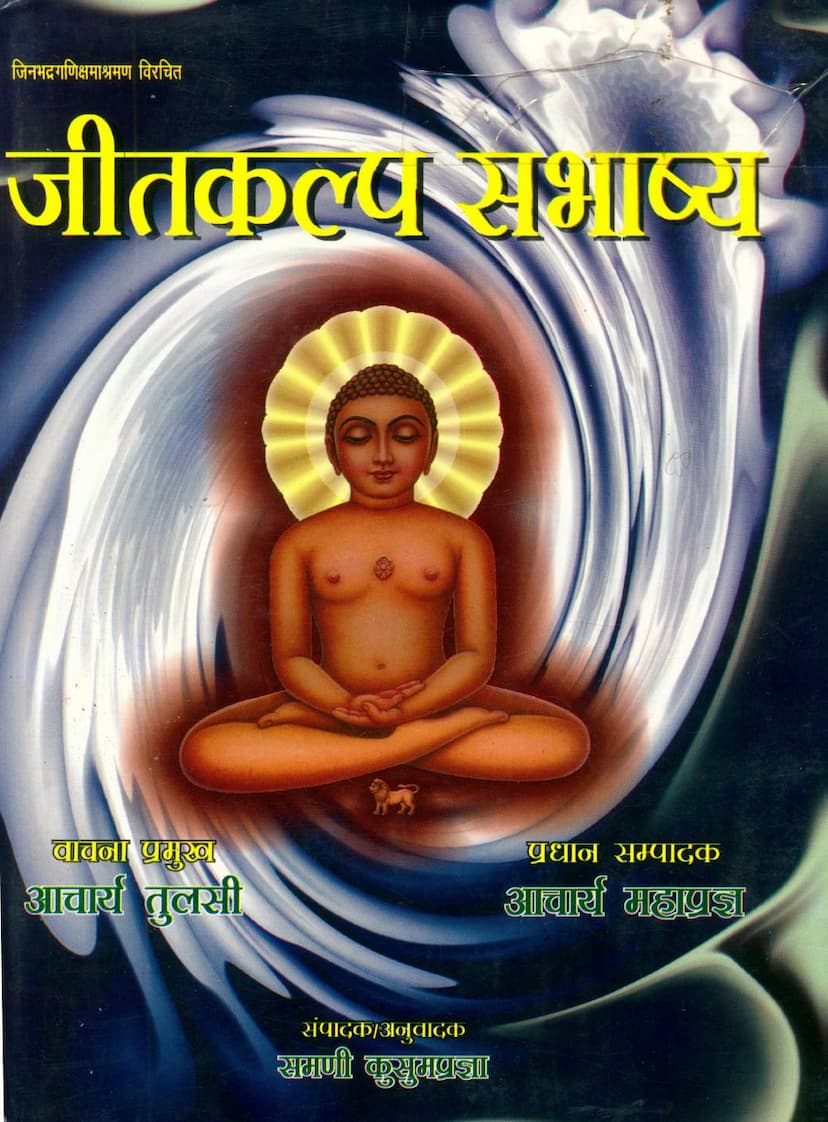Jeetkalp Sabhashya
Added to library: September 2, 2025

Summary
Based on the provided text, here is a comprehensive summary of the Jain text "Jeetkalp Sabhashya":
Title: Jeetkalp Sabhashya Author: Jinbhadra Ganikshamashraman Commentary (Bhashya) Author: Jinbhadra Ganikshamashraman Translator and Editor: Samani Kusumpragya Publisher: Jain Vishva Bharati, Ladnun
Overall Significance: "Jeetkalp Sabhashya" is a significant Jain text, particularly within the tradition of ritualistic literature and penance (prāyashchitta). Although considered "miniature" (laghu-kāya) in comparison to other extensive commentaries like those on Vyavahār and Niśīth, its importance for understanding the tradition of penance is very high. The text, originally composed by Jinbhadra Ganikshamashraman, includes his own commentary (Bhashya). The translation and editing by Samani Kusumpragya, under the overall guidance of Āchārya Tulsī and Āchārya Mahāprajña, make this complex work accessible to a wider audience.
Core Content and Themes:
The primary focus of "Jeetkalp Sabhashya" is prāyashchitta (penance/atonement), particularly within the context of the Jīta-Vyavahār (conduct related to specific rules or circumstances). The text details various types of transgressions and the corresponding expiations.
Key Areas Covered (based on the extensive Table of Contents and chapter discussions):
-
The Importance of the Jīta Sūtra and its Bhashya: The text highlights the significance of Jīta Sūtra as a foundational text on monastic conduct, and its Bhashya as a detailed explanation of these rules and the associated penances.
-
Prāyashchitta (Penance/Atonement): A central theme is the detailed exposition of prāyashchitta, including:
- Why Prāyashchitta is Necessary: It is essential for the purification of conduct (chāritra) and ultimately for the attainment of liberation (moksha).
- Types of Prāyashchitta: The text categorizes and explains various forms of penance:
- Ālōchanā (Confession/Self-criticism): The act of confessing one's faults to a spiritual guide. Its importance, methods, and conditions are discussed.
- Pratikramaṇa (Retrospection/Return): The act of turning away from past transgressions and resolving not to repeat them. Its meaning, types, and offenses are described.
- Tadubhaya (Combination): A penance involving both Ālōchanā and Pratikramaṇa.
- Viveka (Discrimination/Discretion): The process of rectifying impure or unwholesome food, offerings, or conduct.
- Vyutsarga (Renunciation/Abandonment): The practice of renouncing mental, verbal, or physical attachments, often involving Kāyotsarga (standing in a specific posture).
- Tapa (Asceticism/Penance): Various forms of fasting and austerity are prescribed as penance. The text elaborates on the nuances of giving Tapa based on factors like the severity of the offense, the strength of the practitioner, and the availability of resources.
- Cheda (Cessation/Cutting Off): Involving a reduction in monastic seniority or the period of initiation.
- Mūla (Root): More severe penances that address the root cause of the transgression.
- Anavāpya (Unrecoverable/Unsettleable): Penances for serious transgressions where the fault remains in the record or the individual is not fully absolved without specific conditions.
- Pārāñcita (Outcast/Defeated): The most severe penances, often involving expulsion from the monastic order, for grave offenses.
-
Vyavahār (Conduct/Practice): The text extensively discusses different types of conduct and their implications:
- The Five Vyavahārs: Āgama Vyavahār, Śruta Vyavahār, Ājnā Vyavahār, Dhāraṇā Vyavahār, and Jīta Vyavahār. The text delves into their meaning, application, and relationship to penance.
- Āgama Vyavahār: This is further divided into Pratyaksha (direct) and Paroksha (indirect) Āgama Vyavahār. Pratyaksha is again categorized into Indriya-pratyaksha (sensory) and No-Indriya-pratyaksha (non-sensory, like Kevala Jñāna).
- Jīta Vyavahār: This specific type of conduct is emphasized, relating to situations requiring particular rules or penances. The text explores its meanings and applications.
- Pātra (Recipient) and Apātra (Non-recipient): The text discusses the qualifications and disqualifications for performing or receiving penance, emphasizing the importance of the teacher's (āchārya's) merit and knowledge.
- Relative and Absolute Prāyashchitta: The text highlights the flexibility and context-dependent nature of penance, considering factors like time, place, strength of the individual, and the nature of the transgression. This is often illustrated with practical examples and analogies.
-
Key Figures and Concepts:
- Jinbhadra Ganikshamashraman: The author and commentator, praised for his scholarship and dedication to Āgama literature.
- Āchārya Tulsī and Āchārya Mahāprajña: Their pivotal roles in the editing and publication of Āgama texts are acknowledged.
- Samani Kusumpragya: Her crucial work in translating and editing the text is highlighted, emphasizing her dedication and the significance of making these scriptures accessible.
- Chedasūtras: The text discusses the importance and classification of Chedasūtras (texts dealing with monastic discipline and expiation) within Jain canonical literature, including their varying numbers according to different traditions.
- Kāyotsarga: Detailed explanations are provided on Kāyotsarga as a practice for penance, including its types, methods, and etiquette.
- Other Prāyashchitta Types: The text also touches upon other forms like Mūla Prāyashchitta, Anavāpya Prāyashchitta, and Pārāñcita Prāyashchitta, explaining their contexts and implications.
Translation and Editing Effort: The introduction and publisher's note highlight the immense effort involved in the research, compilation, and translation of ancient Āgama texts. Samani Kusumpragya's dedication over 30 years to the field of Āgama literature, her meticulous work on "Jeetkalp Sabhashya," and the subsequent publication by Jain Vishva Bharati are emphasized as a significant contribution to Jain scholarship. The effort to make the original text comprehensible through translation into modern language, while retaining its essence, is noted as a formidable task.
In Essence: "Jeetkalp Sabhashya" is a voluminous work that serves as a detailed manual for understanding and practicing prāyashchitta within Jain monasticism. It meticulously outlines the rules of conduct, the transgressions, and the prescribed penances, reflecting the profound ethical and disciplinary framework of Jainism. The translation makes this ancient wisdom accessible, underscoring the continuous effort to preserve and disseminate Jain teachings.